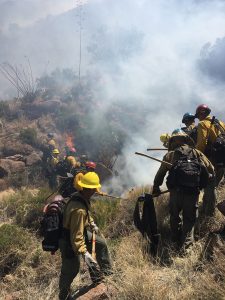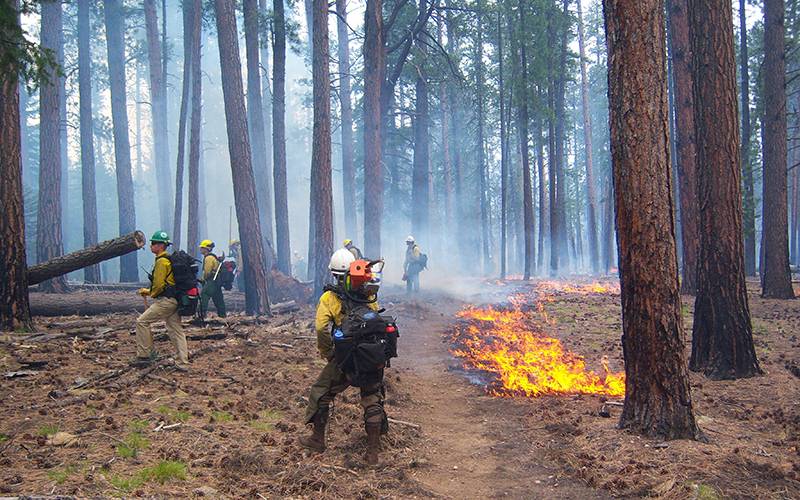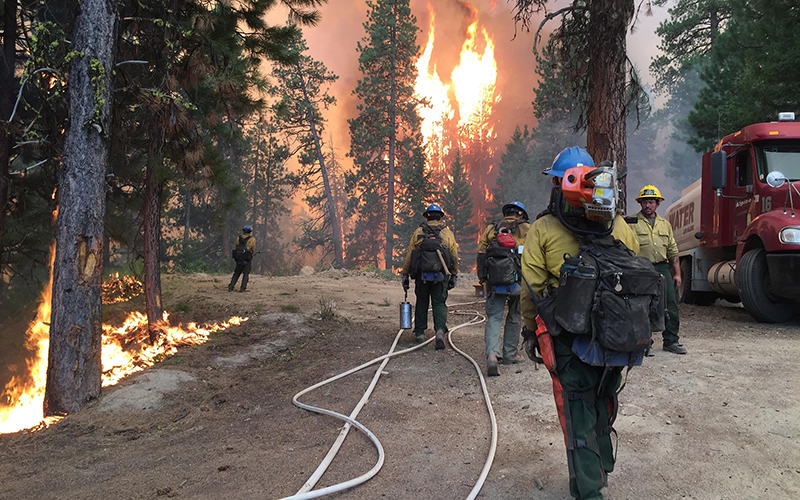PHOENIX – More than 10.3 million acres of land were scorched by wildfires nationwide in 2020. Firefighters battling the harrowing flames often work shifts that exceed 24 hours, and they stay in close quarters in remote locations for weeks at a time, offering a prime opportunity for COVID-19 to spread.
In addition, firefighters in urban areas as well as in wildlands routinely are exposed to smoke, carbon monoxide, toxins from structure fires and other hazards to lung health.
Although there isn’t much data to indicate whether smoke inhalation affects the infection rate or severity of COVID-19 in firefighters, some experts are voicing concerns about lessened lung capacity upon recovery and other health issues.
“There’s definitely the question of whether or not those firefighters who are severely impacted will have trouble regaining lung capacity,” said Luke Montrose, an environmental toxicologist at Boise State University. “They’re already at risk for diseases like camp crud and lung cancer.”
Montrose researches how wood smoke and other air pollution affects the way human health and diseases work – and he’s concerned firefighters may be facing more severe health outcomes because of COVID-19, which easily spreads in close quarters.
As of Feb. 16, trade news site FireRescue1 has tracked COVID-19 related deaths of 66 firefighters across the country, from California to New Jersey. There haven’t been any studies of the impacts of COVID-19 on firefighters, which Montrose said more are needed.
Many firefighters had pandemic-related training and are well-versed in using masks and protective equipment.

Bureau of Land Management wildland staff assist Arizona and federal agencies fight a blaze 15 miles east of Mammoth in 2018. (Photo courtesy of the Bureau of Land Management)
“In our department we were very good about being ready and having a response in place,” Phoenix firefighter Joe Buckley said. “We run medical calls so we’re no strangers to infectious disease, but obviously COVID-19 is very different and we were lucky to be well-prepared for it.”
Fire personnel respond to multiple medical calls on a daily basis, many of which are COVID-19 patients, according to Buckley.
“Even with those of us here who have been asymptomatic and others who have been in the hospital for it, it’s seemed to be very random” when it comes to severity of the illness, Buckley said.
Buckley, 39, tested positive for the virus in October. He successfully avoided hospitalization and completed the 14-day quarantine from his home.
“I began with general fatigue and didn’t feel very well, I lost my sense of taste for a while,” he said. “What was hard was the mental aspect of quarantining, but the support from the chief and my colleagues was very helpful for me.”
The Arizona Department of Forestry and Fire Management says that 2,520 wildfires burned through the state in 2020, making it the state’s worst year for wildfires since 2011. This meant fire personnel were deployed throughout the state throughout the pandemic, working in close contact and facing possible exposures to harsh pollutants and illness.
Although the Centers for Disease Control and Prevention has said people with lung-related preexisting conditions, such as asthma or a history of smoking, are at a higher risk for the coronavirus that causes COVID-19, the smoke inhaled by firefighters is not an official concern listed by the health officials. Montrose and other experts warn that although firefighters may appear to be in prime physical condition, consistent inhalation of smoke can compromise lung health, too.
“There are some health effects that happen immediately, or there can be repeated exposure for the lung damage to happen,” Montrose said.
Firefighters are aware of the potential damage that can be caused by the excess smoke entering their bodies. According to Buckley, they are often required to perform extra training on how to minimize their exposure, and encouraged to limit their exposure to lung irritants of the job.
“This is the reason the fire departments already had such intense procedures when it comes to health and safety,” Montrose said. “So when COVID-19 hit, they were already well-equipped for protection, probably having to make a few tweaks.”
For now, some are raising awareness that firefighters are vulnerable to COVID-19.
In Southern California, Anaheim fire Capt. Joe Aldecoa contracted COVID-19 in June while on the job as a paramedic.
“With all the PPE we were wearing and all the cleaning, I really didn’t think it was going to be possible to catch it,” Aldecoa told the CPF Firewire podcast last summer. “The only way I could think of catching it was, we use iPads, and they sometimes get overlooked in the cleaning process. That’s my theory.”
Like many firefighters across the country, who stay in top shape to meet the physical demands of the job, he believed his healthy lifestyle would prevent infection.
“When I first heard about this, I heard about older people being hospitalized,” he said.
Aldecoa, 47, was less fortunate than Buckley, whose case was mild enough to manage without hospitalization. After testing positive, Aldecoa went to the hospital, but doctors sent him home to quarantine, saying his lungs looked alright. That was a Monday. By Thursday, Aldecoa returned to the hospital, where doctors determined his lungs had filled with fluid.
David Baker, another Anaheim fire captain, had an even worse experience with COVID-19 – he was placed in a medically induced coma to help his recovery.
Since his release in July, Baker has been battling with the unknown.
“The worst part is not knowing the long-term health effects,” Baker told Firewire. “I lost 40 pounds, and a lot of my muscle mass is gone. It’s going to take a long time to build that back up, but as far as everything else, it’s hard to know because there are no long-term studies.”
An important part of these suggested studies would be whether lung tissue damaged by COVID-19 can repair itself. If irreparable, the quality of lung capacity post-virus could remain mediocre at best.
“There are studies that can be done, but they haven’t been done yet,” Montrose said.



